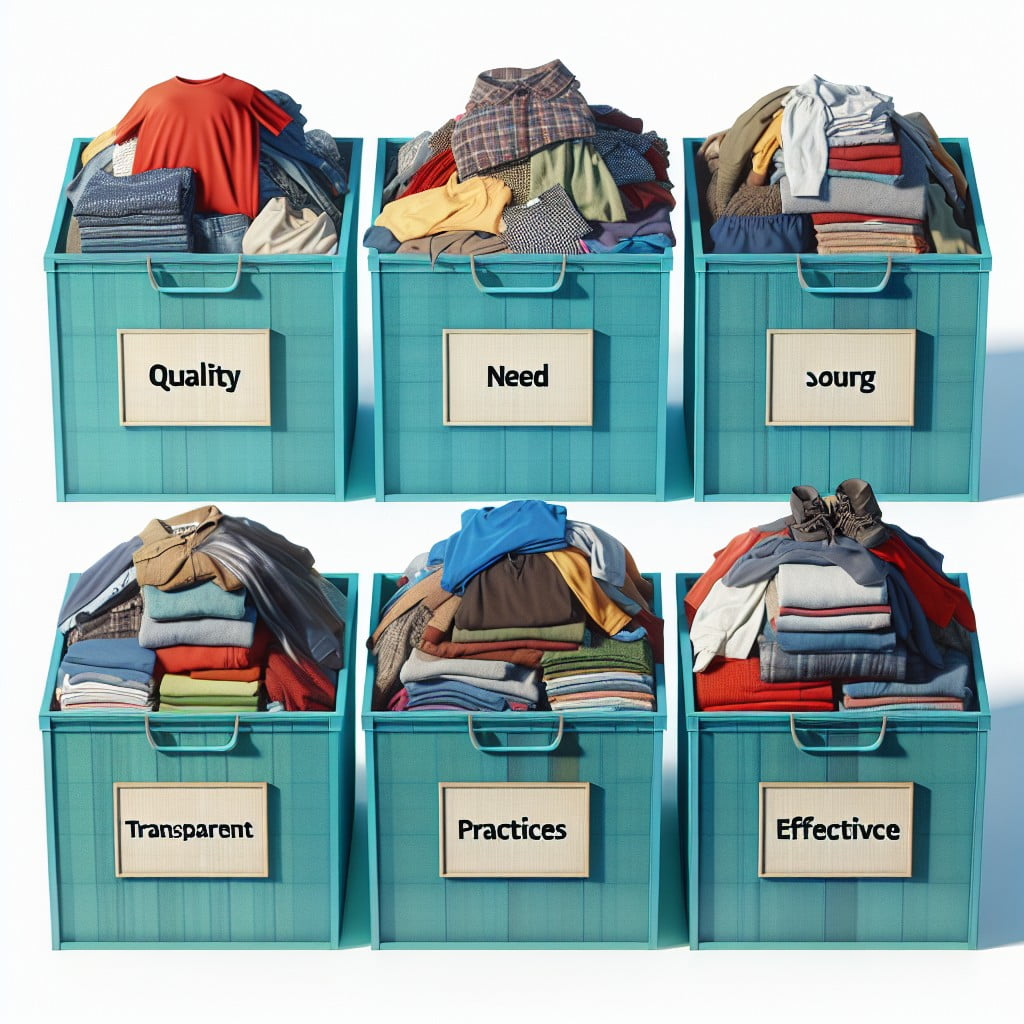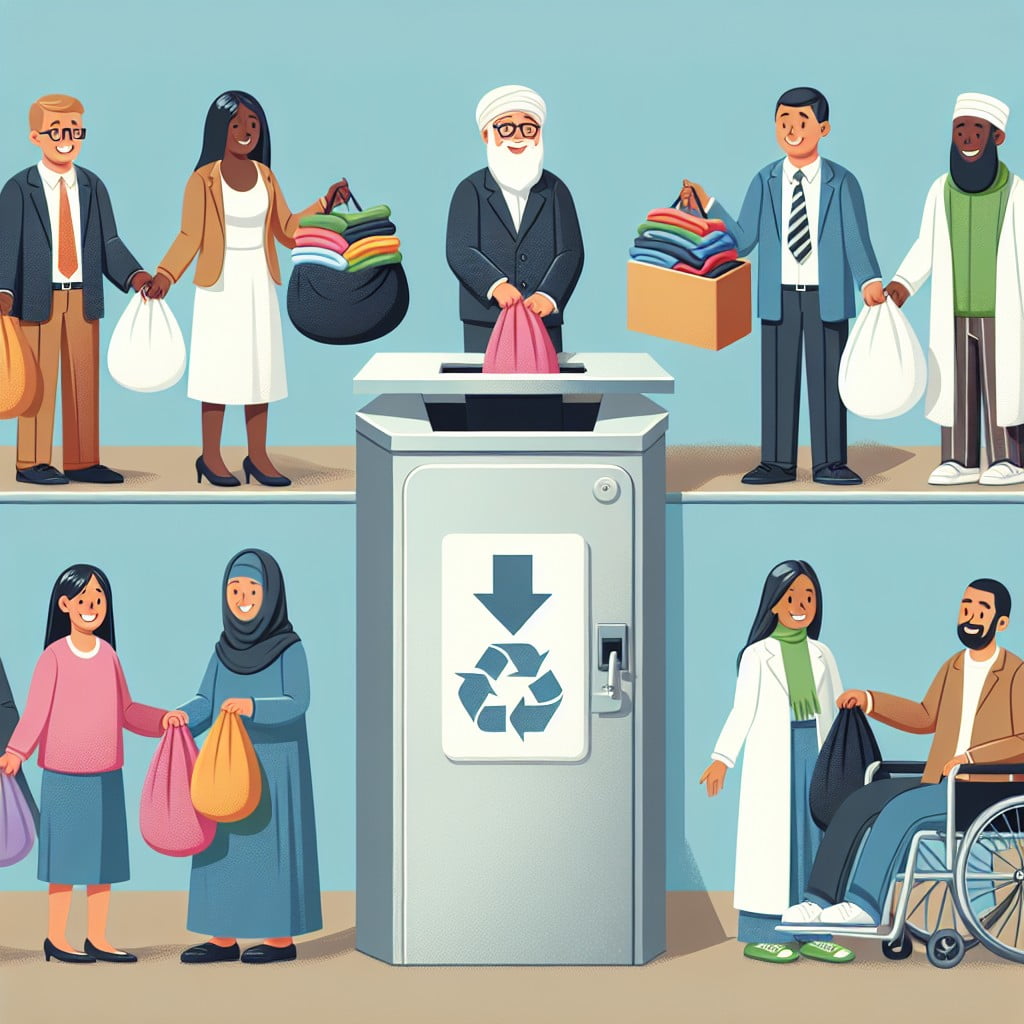Last updated on
Discover excellent ways to repurpose your unused clothes because donating to these top charities empowers communities and reduces waste while being effortlessly impactful.
Key takeaways:
- Donating to transparent charities ensures your contribution genuinely helps others.
- Evaluate a charity’s effectiveness and reach before donating clothes.
- Consider the accessibility of donation options, such as drop-off locations or pick-up services.
- Goodwill, The Salvation Army, Planet Aid, and Dress for Success are top charities for clothing donations.
- Prioritize quality, clean clothing in good condition for donations.
Criteria for Choosing the Best Charities to Donate Clothes To

Selecting the right organization for your clothing donation begins with evaluating their transparency. A reputable charity will provide clear information about how donations are utilized, ensuring that your contribution genuinely aids those in need. Investigate each charity’s effectiveness; organizations should have a track record of positively impacting communities and individuals.
Confirm the charity’s reach and whether it serves local, national, or international communities. This may influence your decision based on your personal preference to support your local community or broader global initiatives.
Accessibility for donors is also crucial. Research how easy it is to donate, including the provision of convenient drop-off locations or pick-up services. A seamless donation process is not only beneficial for you but it can also be a sign of the charity’s operational efficiency.
Looking into these aspects enables you to make an informed decision, ensuring your donations do their intended good.
Transparency and Use of Donations

When selecting a charity, it’s imperative to consider how they utilize donations. A transparent organization will provide clear information about the distribution and use of donated items. Charities should demonstrate a commitment to directing a significant portion of contributions to their programs rather than administrative costs.
Here are a few key points to understand:
- Financial Reports and Accountability: Credible charities openly share their financial statements and reports. These documents reveal the percentage of donations allocated to program services versus administrative expenses.
- Charity Watchdog Ratings: Organizations like Charity Navigator, GuideStar, and the Better Business Bureau’s Wise Giving Alliance evaluate and rate charities based on their transparency, accountability, and financial health.
- Direct Impact: The best charities ensure that donated clothes reach people in need or generate revenue, typically through resale, that supports charitable programs.
- Donor Updates: Transparent charities often communicate with donors about the outcomes and impact of their donations, providing a clear connection between your contribution and its benefits.
By focusing on these aspects, you can feel confident that your clothing donations are making a meaningful difference.
Efficiency and Impact

When assessing where to donate clothes, evaluating a charity’s efficiency is crucial. This involves how effectively an organization directs donations towards its intended cause, rather than administrative expenses. A higher efficiency rating means more of your donated items directly support those in need.
The impact of a charity is also a key consideration. It measures the tangible outcomes of donations on the community. Charities with a high impact not only distribute clothing but also provide programs that empower the recipients, such as job training or support services.
To gauge these factors, consult resources like Charity Navigator or GuideStar, which provide insights into a charity’s financial health and accountability. Look for organizations with high ratings for financial efficiency and transparency. Additionally, read about the charity’s mission and success stories to understand their real-world impact. This research ensures that your donation makes the most meaningful difference.
Accessibility for Donors

Choosing a charity that makes donating clothes hassle-free is crucial for a positive experience. Several factors influence accessibility:
- Location of Drop-Off Points: Charities with numerous drop-off bins or stores are more convenient. A quick online search can provide the nearest location.
- Pick-up Services: Some organizations offer home pick-up for donations, which can be a time-saver for busy individuals.
- Donation Hours: Extended hours for donations including weekends or evenings accommodate various schedules.
- Online Accessibility: Charities with well-maintained websites and online scheduling for donations simplify the process.
By considering these points, donating becomes a straightforward act of goodwill, ensuring your contributions reach those in need without adding stress to your day.
Top Charities for Clothing Donations
Goodwill operates nationwide, offering job training and employment services, funded in part through the sale of donated clothes. Bring your gently used items to their many drop-off locations, or use the Goodwill locator on their website to find the nearest donation bin.
The Salvation Army uses proceeds from their thrift stores to fund rehabilitation programs and disaster relief efforts. You can schedule a pickup for large donations or find a nearby drop-off location online.
Planet Aid’s yellow bins are hard to miss. Dedicated to environmental sustainability and global development, they make it easy to donate clothing. Just drop your items in a bin—locations are listed on their website.
Dress for Success focuses on empowering women by providing professional attire for job interviews. They accept nearly new, business-appropriate clothing. Check their site to find local affiliates and specific donation needs or events.
Each organization has unique guidelines and accepts different types of clothing—checking their websites before donating ensures your items will be put to the best use.
Goodwill
Goodwill stands out for its sprawling network of thrift stores and donation centers, making it convenient for a wide geographic demographic to contribute. When you donate clothing to a local Goodwill, the items are typically sold in the stores, and the proceeds fund job training programs, employment placement services, and other community-based initiatives. These programs are essential in their mission to strengthen communities by supporting individuals who are seeking to improve their career opportunities and gain self-sufficiency.
Notably, Goodwill accepts a variety of clothing for men, women, and children, including outerwear and footwear. Before donating, ensure items are in good condition, laundered, and free from major tears or stains. Donors can take advantage of Goodwill’s easy-to-use website to find their nearest donation sites or to check for specific guidelines and accepted items.
Goodwill is also a good choice for those seeking a tax deduction for their donations; they provide donors with a receipt that can potentially be used for tax purposes. Donors are encouraged to keep an itemized list of donated goods for their records.
By choosing Goodwill, you’re not just decluttering your home – you’re actively contributing to a circular economy and making a positive impact on the lives of others within your community.
The Salvation Army
Operating since 1865, The Salvation Army offers multiple programs that extend beyond clothing donations, including disaster relief and rehabilitation services. When you donate clothing to this organization, you are supporting a network that aids individuals and families in need across various communities.
Here’s what you should know:
- Locations: With numerous drop-off points and thrift stores nationwide, donating is convenient.
- Donation Receipt: They provide receipts for tax deduction purposes, so remember to ask for one when you drop off your donations.
- Broad Impact: Your donations help fund rehabilitation programs, underlining the significant social impact of your contribution.
- Variety: They accept a wide range of clothing for men, women, and children, including outerwear, professional attire, and casual wear.
- Easy Giving: For large donations or bulky items, The Salvation Army can schedule a pickup directly from your home.
Before you donate, ensure that the clothes are clean and in good condition to help maintain the dignity of those who receive them.
Planet Aid
Planet Aid stands out for its iconic yellow donation boxes, which make dropping off used clothing convenient. The nonprofit organization is dedicated to protecting the environment and supporting sustainable development in impoverished communities around the world.
Here are key points that encapsulate their mission and operations:
- Global Reach: Proceeds from the resold clothing fund educational, health, and agricultural initiatives across Africa, Asia, and the Americas.
- Environmental Focus: Planet Aid’s mission includes a strong commitment to environmental stewardship, promoting the recycling of textiles to minimize waste.
- Easy to Use: The yellow bins are accessible 24/7, located in various public spaces, enabling donors to drop off clothing at their convenience.
- Acceptance Criteria: They accept a wide range of textiles, not just clothing. This includes shoes, bedding, and even cloth scraps.
- Transparency: Detailed information on the allocation of funds and the specific projects supported can be found on Planet Aid’s website.
- Tax-Deductible: Donations to Planet Aid are tax-deductible, with receipts available directly on their bins or online.
By choosing to donate to Planet Aid, donors contribute to both global development and the reduction of environmental impact, advocating for a greener planet and better living conditions worldwide.
Dress for Success
Dress for Success focuses on empowering women to achieve economic independence by providing a network of support, professional attire, and the development tools to help them thrive in work and life.
When donating to this organization, consider the following:
- Professional Apparel: The charity mainly seeks work-appropriate clothing which can be worn for job interviews or in a professional environment. This includes suits, blouses, dress shoes, and accessories.
- Current Styles: To ensure clients have the best chance of success, current, gently used, or new clothing is preferred. It should be in style, clean, and in good condition.
- Appointment-Based Donations: Unlike some other organizations, donations are often made by appointment to ensure the right items are collected at the right time.
- Local Impact: Each affiliate aids women in the immediate community, so your contributions directly support those in your area.
- Financial Support: Beyond clothing, monetary donations also greatly benefit their programs and services, such as career counseling and job readiness workshops.
Considerations for Donating Clothes
When selecting garments to donate, prioritize quality over quantity. Aim to give items that are gently used, free from stains, tears, and excessive wear. Ensure clothing is laundered and, if possible, free from pet hair or smoke odors.
Some organizations may accept professional attire specifically to help individuals prepare for job interviews, while others might have a greater need for everyday clothing. Seasonal appropriateness can also be a factor; consider donating coats in the winter or lighter attire in the summer.
Always check the charity’s current needs, as they may change over time or have category-specific requirements. Remember, your well-considered donations can make a significant difference in someone’s life while demonstrating respect for the charity’s resources.
Condition of Clothing Accepted
To ensure your donated garments are suitable for use, adhere to a few basic quality standards. Most organizations prefer lightly worn or nearly new items. Clothing should be free from rips, stains, and odors. Additionally, check for working zippers and intact buttons. The goal is to donate pieces that others can wear with confidence and dignity.
It’s also wise to consider the season—warm coats are in high demand during winter, while summer clothes might be more useful as temperatures rise. Before you donate, a quick assessment of the condition will maximize the benefit your donation provides to the recipient.
Types of Clothing Items Needed
Charities typically have high demand for specific types of clothing due to their practicality and versatility. Everyday wear such as t-shirts, jeans, and jackets are always needed, especially in adult and children’s sizes.
Seasonal items like coats, gloves, and hats are particularly welcomed during colder months. Professional attire, including suits and business-appropriate clothing, are sought after by organizations that help job seekers.
For those in crisis situations, new underwear and socks are crucial and often requested. Always ensure the items are in good condition, without tears or stains, to ensure they can be used by someone else effectively.
Preparing Your Clothes for Donation
Ensure that all garments are clean and laundered; nobody has any desire to sort through dirty laundry. Inspect each item carefully to make sure it’s free from severe damage such as large tears or broken zippers. Minor repairs like sewing on a button or fixing a loose thread can increase the likelihood of your items being worn again.
Sort clothing by category (e.g., shirts, pants, outerwear), as some organizations have specific needs. Additionally, check the charity’s website or call ahead to confirm their current needs and restrictions. Avoid donating clothes that are too worn out or damaged; consider textile recycling options for these items instead.
Make a list of your donated items for your records, as many organizations can provide a tax deduction receipt upon request.
Washing and Repairing Clothes
Before donating your garments, a clean presentation is vital. Ensure they are laundered and free from stains and odors. This not only shows respect for the next wearer but also reduces the workload on charity staff.
Small repairs, such as fixing loose buttons or mending minor tears, can make a big difference, extending the item’s life and making it immediately usable for someone in need. Stick with basic modifications that don’t alter the original design of the clothing, to keep the items versatile for a broader audience.
Remember, the goal is to give clothes a second life, not just to discard them.
Adhering to the Charity’s Guidelines
Before bagging up your garments, take a moment to review the specific guidelines provided by the organization you’ve chosen. These details are key to ensuring your items are suitable and beneficial. Here are some pointers to keep in mind:
- Check for Acceptable Items: Not all clothing is appropriate for every charity. Some focus on work attire, while others may prioritize children’s clothing or outerwear.
- Seasonal Considerations: Many organizations seek seasonally appropriate clothing. Lighter clothes might be preferred in the spring and summer, heavier garments in fall and winter.
- Quality Over Quantity: Charities often ask for gently used items. A good rule of thumb is donating clothes in a condition you’d feel comfortable wearing again.
- Special Requirements: Some groups have unique needs, like unopened packs of socks or undergarments for hygiene reasons.
- Packing Standards: Certain charities request that clothes be packed in boxes, while others accept bagged items. Ensure they’re sealed securely.
Remember, adhering to these guidelines helps the charity streamline their process and make the most of your generosity.
FAQ
Where is the most ethical place to donate clothes?
The most ethical place to donate clothes is at Planet Aid, a non-profit organization that accepts various types of clothing and also supports multiple community initiatives.
What charity should I donate clothes to?
You should donate your clothes to your local Oxfam shop, where they can be sold to help fight poverty.
What clothes are good for donation?
Clothes that are ideal for donation are those in good condition that you seldom wear, including potentially high-end items like formal dresses or suits.
Which charities accept different types of clothing donations?
Charities such as Goodwill, The Salvation Army, American Red Cross, and Dress for Success accept various types of clothing donations.
How does the process of donating clothing to charities work?
Donating clothing to charities involves gathering gently-used items, researching local charities that accept clothes, dropping off the donated items or scheduling a pickup, and optionally obtaining a tax-deductible receipt for the donation.
What impact can clothing donations have on the beneficiaries of these charities?
Clothing donations can significantly provide essential items for those in need, reducing their financial burden and contributing to their well-being.
Recap:




